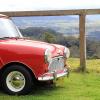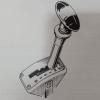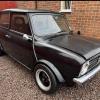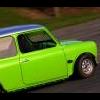Rear Toe
#1

Posted 20 February 2025 - 08:11 AM
#2

Posted 20 February 2025 - 08:32 AM
If you are adding shims between the body and subframe as you mention it won’t work to correct toe?
You need the shims between the subframe and the outer radius arm bracket
#3

Posted 20 February 2025 - 08:55 AM
#4

Posted 20 February 2025 - 09:00 AM
#5

Posted 20 February 2025 - 09:32 AM
Looking at it again the shims are u shaped and I have them fitted between the radius arm bracket and the rear subframe heel board mounting is this correct
Yes.
I'll add that normally, Minis suffer from toe out rather than toe in, in which case, no amount of shimming is ever going to help.
I'd first suggest checking the subframe here, that the trailing arm pin holes are not elongated, especially on the inboard side and that when the outer brackets are fitted (without the arms) that all 4 holes are in alignment. Then check the bush and bearings on the arms are good. After that, if it's still wrong, it's likely one (or both) of the trailing arms are bent, a somewhat common issue. I have a jig for checking them, but without one, I'm not sure how the guy at home can easily check the arms.
#6

Posted 20 February 2025 - 04:18 PM
#7

Posted 20 February 2025 - 10:06 PM
Just to add, it's absolutely vital that the rear wheels have some toe-in. I believe that the biggest cause of poor handling and twitchy road-holding is the rear wheels not toeing-in the correct amount.
The ideal settings for a road mini at the rear are zero to 0.5 degrees negative camber and 1/8" to 3/16" toe-in (across both wheels, not per side).
If the toe-in is too much, add shims. If it's toeing out, or not toeing-in enough, file the holes in the outer brackets forwards and, when it's correct, weld some large washers onto the brackets to hold the setting. It's not as difficult as it sounds.
Of course, you can go to a professional operation to get the settings correct, but you can do it yourself with two lengths of straight timber or two lengths of steel angle about 6 ft long to check and set the toe-in and a rectangular board about 18" x 24" to check and set the camber.
#8

Posted Yesterday, 02:17 AM
How are you measuring the toe?
#9

Posted Yesterday, 07:07 AM
How are you measuring the toe?
Probably use the steel angle pressed against the outer face of the tyre and making a mark at the end of the angle when pointing forwards and when pointing backwards. do it on both sides 3 times with 120 degree rotation between markings then move the car and measure between the marks. Then calculate the angle from the differences between the averages of the two sets of marks and the length between front and back markings. I've been using that method ever since I started working on my own cars though I tend to use a length of wood not quite as long as that and spaced off the tyre with blocks to ensure clearance from wings.
#10

Posted Yesterday, 08:06 AM
Just to add, it's absolutely vital that the rear wheels have some toe-in. I believe that the biggest cause of poor handling and twitchy road-holding is the rear wheels not toeing-in the correct amount.
The ideal settings for a road mini at the rear are zero to 0.5 degrees negative camber and 1/8" to 3/16" toe-in (across both wheels, not per side).
If the toe-in is too much, add shims. If it's toeing out, or not toeing-in enough, file the holes in the outer brackets forwards and, when it's correct, weld some large washers onto the brackets to hold the setting. It's not as difficult as it sounds.
Of course, you can go to a professional operation to get the settings correct, but you can do it yourself with two lengths of straight timber or two lengths of steel angle about 6 ft long to check and set the toe-in and a rectangular board about 18" x 24" to check and set the camber.
Do you use the side of the car as initial datum to ensure your angle lengths are parallel to the car ?
#11

Posted Yesterday, 12:16 PM
If they're parallel to the sides of the car then they've got toe out as the car is tapered. In fact original cills have a slight curve to them too.
I wouldn't trust the side of the car to make any measurements from.
Edited by GraemeC, Yesterday, 12:17 PM.
#12

Posted Yesterday, 12:31 PM
So where do you take them from ?If they're parallel to the sides of the car then they've got toe out as the car is tapered. In fact original cills have a slight curve to them too.
I wouldn't trust the side of the car to make any measurements from.
#13

Posted Yesterday, 02:10 PM
I just want to know how the OP has determined they have an issue. It's not the first time someone has posted on a mini forum saying they've fitted a thick spacer and still have an issue. Last time it happened it turned out to be a measurement issue. It's easy to get wrong when you have little understanding of what you are measuring etc.Probably use the steel angle pressed against the outer face of the tyre and making a mark at the end of the angle when pointing forwards and when pointing backwards. do it on both sides 3 times with 120 degree rotation between markings then move the car and measure between the marks. Then calculate the angle from the differences between the averages of the two sets of marks and the length between front and back markings. I've been using that method ever since I started working on my own cars though I tend to use a length of wood not quite as long as that and spaced off the tyre with blocks to ensure clearance from wings.How are you measuring the toe?
I have a professional aligner from the 60s/70s which accurately measures toe, thrust angle, set-back, camber, castor and kpi.
Edited by 68+86auto, Yesterday, 02:13 PM.
#14

Posted Yesterday, 04:45 PM
I just want to know how the OP has determined they have an issue. It's not the first time someone has posted on a mini forum saying they've fitted a thick spacer and still have an issue. Last time it happened it turned out to be a measurement issue. It's easy to get wrong when you have little understanding of what you are measuring etc.
Probably use the steel angle pressed against the outer face of the tyre and making a mark at the end of the angle when pointing forwards and when pointing backwards. do it on both sides 3 times with 120 degree rotation between markings then move the car and measure between the marks. Then calculate the angle from the differences between the averages of the two sets of marks and the length between front and back markings. I've been using that method ever since I started working on my own cars though I tend to use a length of wood not quite as long as that and spaced off the tyre with blocks to ensure clearance from wings.How are you measuring the toe?
I have a professional aligner from the 60s/70s which accurately measures toe, thrust angle, set-back, camber, castor and kpi.
Ah, OK, I misunderstood your question.
1 user(s) are reading this topic
0 members, 1 guests, 0 anonymous users



















